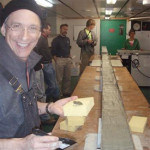 Imagine this at the Weather Channel. The announcer is sitting on a beach waiting for a wave that comes once every four hours. He sits there eight hours, at least, to notice the wave roll in twice. To formulate a testable hypothesis about the periodicity he sits in the chair for a week. To understand the effect of the wave he will sit there for a month, or design an instrument to do it for him.
Imagine this at the Weather Channel. The announcer is sitting on a beach waiting for a wave that comes once every four hours. He sits there eight hours, at least, to notice the wave roll in twice. To formulate a testable hypothesis about the periodicity he sits in the chair for a week. To understand the effect of the wave he will sit there for a month, or design an instrument to do it for him.
This is one reason why oceanographers seem to live in another world. They occupy a different space-time continuum than we do. We can only wish we had the time to watch a large internal wave breaking onshore every four hours in the South China Sea, dropping temperature by 8 degrees C to fuel a phytoplankton bloom one week later.
Internal waves are in a different phase-space than wind-driven surface waves. They occur between large water masses of different densities, along a boundary between thick layers distinguished by their temperature and salinity. In a stratified ocean, low frequency waves between these layers “break” as deeply as 30, 40, or 100m. These waves move slowly, and unnoticeably, but they may be partly responsible for periodic transport of plankton and nutrients into the coral reef zone in the South China Sea.
See the abstract of the new paper by Wang et al 2007 in Geophysical Research Letters,
http://www.agu.org/pubs/crossref/2007/2007GL030658.shtml






…working with passion :)